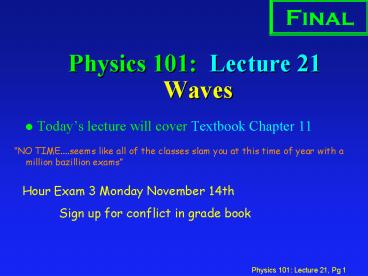Physics 101: Lecture 21 Waves - PowerPoint PPT Presentation
1 / 18
Title:
Physics 101: Lecture 21 Waves
Description:
Hour Exam 3 Monday November 14th. Sign up for conflict in grade book ' ... waves at football games, waves if you're the Miss Universe, and many other waves. ... – PowerPoint PPT presentation
Number of Views:708
Avg rating:3.0/5.0
Title: Physics 101: Lecture 21 Waves
1
Physics 101 Lecture 21 Waves
Final
- Todays lecture will cover Textbook Chapter 11
NO TIME....seems like all of the classes slam
you at this time of year with a million bazillion
exams
Hour Exam 3 Monday November 14th
Sign up for conflict in grade book
2
Comments
ANYTHING WHERE YOU DO NOT LIST EXACTLY WHAT THE
VARIABLES ARE I FIND DIFFICULT
I know everything about waves, physics waves,
waves at football games, waves if you're the Miss
Universe, and many other waves. SO BOOYA
WAVES!!!!!
Waves and fluids suck! They are so hard to
understand!!!!
all of the strange variables confuse me. what's
the funny little upside-down "y"?
By the way, is the final comprehensive? In the
lecture notes it says "final" on the top of the
last few lectures, so I wasn't sure if only that
material would be covered in the final.
I think that there is so much information given
to you at once and you really don't have that
much time to digest it before you apply it. If
you haven't had exposure to the material before
it is difficult to follow.
im confused with different harmonics and the
overtones
3
Waves Overview
- Types
- Speed
- Harmonic
- Superposition
- Standing
05
4
Types of Waves
didn't understand why things were longitude
waves or whatever ... i don't understand the
differences btwn waves ... a wave is a wave ...
to me talking about waves its hard because i cant
see them so its very hard to JUST believe they
are there ....CONVENCE ME PLEASE!!
8
5
Slinky Preflight 3
- Suppose that a longitudinal wave moves along a
Slinky at a speed of 5 m/s. Does one coil of the
slinky move through a distance of five meters in
one second? - 1. Yes
- 2. No
I really have no idea im just a "yes-man." I've
got middle management written all over me.
The wave moves through a distance of 5 meters in
one second but each coil moves a very small
distance
12
6
Velocity of Waves Act
A spring and slinky are attached and stretched.
Compare the speed of the wave pulse in the slinky
with the speed of the wave pulse in the spring.
A) vslinky vspring B) vslinky vspring C)
vslinky Slinky is stretches more, so it has a smaller
mass/length m.
17
7
Harmonic Waves
y(x,t) A cos(wt kx)
Wavelength The distance ? between identical
points on the wave.
Amplitude The maximum displacement A of a point
on the wave.
Angular Frequency w w 2 p f
Wave Number k k 2 p / l
Recall f v / l
y
x
20
8
Period and Velocity
22
9
Harmonic Waves Exercise
- y(x,t) A cos(wt kx)
- Label axis and tic marks if the graph shows a
snapshot of the wave - y(x,t) 2 cos(4t 2x) at x0.
- Recall T 2 p /w
T 2 p / w 2 p/ 4 1.58
25
10
Preflight 12
- Suppose a periodic wave moves through some
medium. If the period of the wave is increased,
what happens to the wavelength of the wave
assuming the speed of the wave remains the same?
- 1. The wavelength increases
- 2. The wavelength remains the same
- 3. The wavelength decreases
? v T
26
11
ACT
The wavelength of microwaves generated by a
microwave oven is about 3 cm. At what frequency
do these waves cause the water molecules in your
burrito to vibrate ?
(a) 1 GHz (b) 10 GHz (c) 100 GHz
1 GHz 109 cycles/sec
The speed of light is c 3x108 m/s
29
12
ACT Solution
Recall that v lf.
1 GHz 109 cycles/sec
The speed of light is c 3x108 m/s
30
13
Absorption coefficientof water as a functionof
frequency.
31
14
Interference and Superposition
- When too waves overlap, the amplitudes add.
- Constructive increases amplitude
- Destructive decreases amplitude
34
15
Reflection Act
- A slinky is connected to a wall at one end. A
pulse travels to the right, hits the wall and is
reflected back to the left. The reflected wave
is - A) Inverted B) Upright
- Fixed boundary reflected wave inverted
- Free boundary reflected wave upright
37
16
Standing Waves Fixed Endpoints
- Fundamental n1
- ln 2L/n
- fn n v / (2L)
I did not really understand what the point or
meaning of the fundamental frequency was.
44
17
Standing Waves
A guitars E-string has a length of 65 cm and is
stretched to a tension of 82N. If it vibrates
with a fundamental frequency of 329.63 Hz, what
is the mass of the string?
v2 F / m m F / v2 m F L / v2
82 (0.65) / (428.5)2
2.9 x 10-4 kg
v l f 2 (0.65 m) (329.63 s-1) 428.5
m/s
48
18
Summary
- Wave Types
- Transverse (eg pulse on string, water)
- Longitudinal (sound, slinky)
- Harmonic
- y(x,t) A cos(wt kx) or A sin(wt kx)
- Superposition
- Just add amplitudes
- Reflection (fixed point inverts wave)
- Standing Waves (fixed ends)
- ln 2L/n
- fn n v / 2L
50































